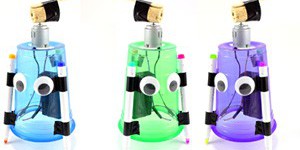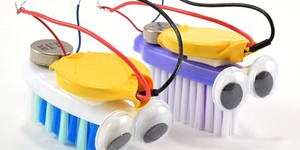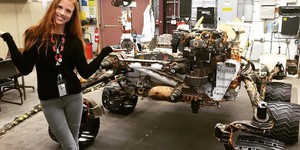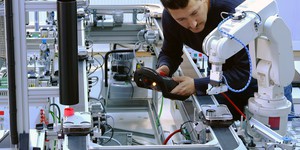Summary
This project is based on Bristlebot: A tiny directional vibrobot by Evil Mad Scientist Laboratories.
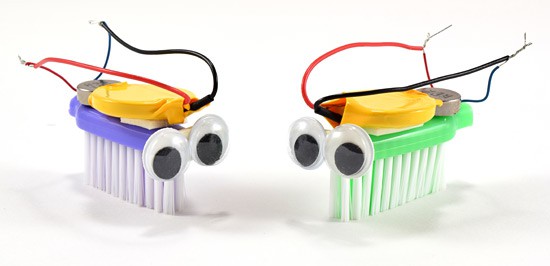
Introduction
Do you think you could build a robot on the head of a toothbrush? Bristlebots are simple, tiny robots that buzz around like bugs. They are easy to build and fun to play with, and you do not need any previous experience with robotics to make one. You can even build two bristlebots and race them against each other! Move on to the Materials section to see what parts you need to build bristlebots, and the instructions for step-by-step directions on how to build them.Materials
- Bristlebot Robotics Kit, available from our partner Home Science Tools. You will need these parts from the kit:
- Coin cell battery
- Vibration motor
- You will also need the following materials, which are not included in the kit:
- Toothbrush head with the handle cut off
- Small piece of double-sided foam tape
- Scissors
- Note: The kit includes enough parts to build two bristlebots, and two other types of simple robots. See the kit instructions page for details.
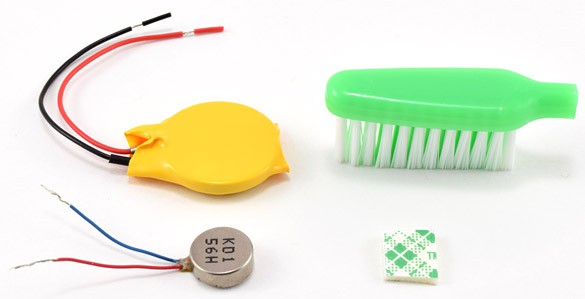 Image Credit: Ben Finio, Science Buddies / Science Buddies
Image Credit: Ben Finio, Science Buddies / Science Buddies
Disclaimer: Science Buddies participates in affiliate programs with Home Science Tools, Amazon.com, Carolina Biological, and Jameco Electronics. Proceeds from the affiliate programs help support Science Buddies, a 501(c)(3) public charity, and keep our resources free for everyone. Our top priority is student learning. If you have any comments (positive or negative) related to purchases you've made for science projects from recommendations on our site, please let us know. Write to us at scibuddy@sciencebuddies.org.
Instructions
- Ask an adult to help you cut the head off a toothbrush using a strong pair of scissors or pliers.
- Follow along with the video to assemble your bristlebot.
 Be gentle with the motor wires. They are thin and can rip if you are not careful. You can apply a dab of hot glue at the base of the wires to reinforce them.
Be gentle with the motor wires. They are thin and can rip if you are not careful. You can apply a dab of hot glue at the base of the wires to reinforce them.
- Follow these troubleshooting tips when using your bristlebot:
- Do not let the exposed metal parts of the red and black wires touch each other directly. This will create a short circuit and drain the battery very quickly, and will prevent the motor from vibrating.
- If your robot stops moving suddenly, check to make sure that one or both sets of wires did not come loose. This will create an open circuit and prevent the motor from vibrating. Tightly twist the wires back together if this happens.
- If your robot falls over a lot, make sure the motor and battery are centered on top of the toothbrush. You can also let the robot run continuously for 3 minutes, and it will slow down slightly as the battery begins to drain.
- To turn your bristlebot off, just untwist one set of wires (you do not need to disconnect both). Make sure you turn your robot off when not in use to conserve battery power.
What Happened?
When you connected the motor and battery wires, you created a closed circuit. This causes electricity to flow through the motor. The motor is the same type found in cell phones and video game controllers to make them vibrate. The electricity makes a tiny weight inside the motor spin, which causes the entire robot to wobble. This makes the bristlebot buzz around the table.
Digging Deeper
When you connected the battery's and motor's wires, you completed a circuit. This allowed electricity to flow in a loop from the battery, through the red wires to the motor, and through the black/blue wires back to the battery. Electricity needs a closed circuit (or a complete loop) to flow. If you only connected one set of wires, the motor would not turn on, because you would have an open circuit. This is why you can turn the bristlebot on and off by disconnecting one set of wires.The metal wires of your circuit are conductors, meaning they allow electricity to flow. They are coated with colored (red and black/blue) plastic, which is an insulator that does not let electricity flow. It is okay for the insulated plastic parts of the wires to touch each other; however, you have to avoid letting the exposed metal parts of the opposite wires touch, because this can create a short circuit and cause your battery to drain very quickly.
Ask an Expert
For Further Exploration
- Your Bristlebot Kit came with enough parts to build two bristlebots. Build a second bristlebot with a different type of toothbrush head, and race them against each other. For example, make one with straight bristles and one with slanted bristles, and compare them.
- Combine the parts from your kit to build a single, larger bristlebot with two motors and two batteries (you might need to use two toothbrush heads side-by-side to keep it from falling over). How does its motion compare to the single-motor bristlebot? Is it faster or slower? Does it go straight or turn more?
- Make a maze for your bristlebot out of cardboard. Even though its motion is random, can the bristlebot eventually find its way out of the maze?
- If you have trouble with your bristlebot falling over, try attaching short pipe cleaners as "training wheels." Do they help keep the robot upright?
Related Resources
Project Ideas
Links
- Blog Post: Building Bristlebots: Basic Toothbrush Robotics
- Blog Post: Bot Building for Kids and Their Parents: Celebrating Student Robotics



